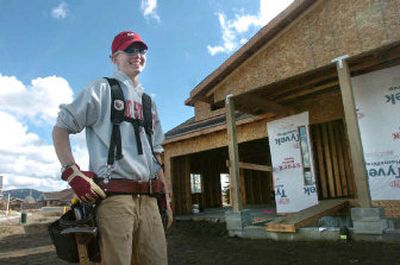Construction jobs booming

In Phoenix, where Amber Phillips grew up, the horizon was filled with skeletons of new buildings. The Rathdrum Prairie, the 18-year-old carpentry student has noticed, is heading the same way.
Three new homes are under construction on Voltaire Drive in Coeur d’Alene, where Phillips and other North Idaho College students are building the college’s annual raffle house. With the area’s building boom sharpening demand for construction workers, students in the 10-month program are already entertaining job offers.
“I’ve had people calling all year, looking for employees,” said Dave McRae, NIC’s carpentry instructor. “They’ll get hired pretty easily,” he predicted.
Phillips has feelers out to several firms. “There’s a Sandpoint company that wants me to work for them,” she said. She’s weighing a second year of schooling against the immediacy of a paycheck and on-the-job training. Either way, job prospects look good for Phillips, who frequently finds herself studying buildings and picturing the support structure beneath the drywall.
Nearly one in every three new North Idaho workers wears a hard hat and carries a nail gun. According to state figures, the region has added 3,000 new construction jobs in the last three years. Kootenai County, with its explosive population growth, has led the way.
In 2005, the county ranked 18th nationally among 450 metropolitan areas for fastest percentage growth in construction jobs. Spokane County ranked 32nd.
Both population and job growth are reflected in the numbers, said Randy Barcus, Avista Corp.’s chief economist.
“An economy can’t grow at all without growth in structures – houses, office buildings, schools, churches,” he said. “Every time I drive down Northwest Boulevard, I’m amazed at what has cropped up.”
The rapid growth has also created a highly competitive field for construction workers and related industries. Local help-wanted ads are brimming with listings for framers, landscapers, concrete workers and heating-and-ventilation technicians.
Bruce Ogilvie is trying to hire 10 framers. He started a Post Falls construction firm last year, and has found that his capacity to expand the firm is limited by his ability to get good workers.
“It’s hard to find the quality of person you want,” said Ogilvie, owner of Bruce & Associates.
Wages are also rising as a result of the tight market. An experienced farmer, who can lead a crew, commands wages of $17 per hour, Ogilvie said.
In Kootenai County, the average annual wage in the construction industry was nearly $31,500 last year – a 9.4 percent increase in two years.
Entry-level wages for carpenters rose 11 percent during the same period to nearly $12 per hour, according to state data. Wages for construction labors rose nearly 19 percent to $9.35 per hour. Those figures are actually low, because they reflect wages for a 10-county region including north-central Idaho, where job growth hasn’t been nearly as strong, said Kathryn Tacke, a regional economist for the state.
The shortage of construction workers is a national issue, as well as a regional one, said Dean Haagenson, president of Contractors Northwest Inc. According to federal estimates, the construction industry will need about 1 million new workers between 2002 and 2012, ranking it among the nation’s top 10 fastest-growing industries. Training more workers, Haagenson said, is critical.
Regionally, the demand for construction workers isn’t likely to abate, either, said Barcus, the Avista economist. Nationally, the number of new home starts is projected to drop off modestly this year. Economists are also projecting a slowdown in U.S. home price gains – from about 12 percent to 6 percent – given rising inventories of unsold homes.
But regional growth, Barcus predicts, will outstrip the national growth rate over the next few years.
He recently revised his home-price forecasts for the Kootenai-Spokane housing market, projecting that housing prices will rise by 30 percent over the next three years. Barcus based his optimistic forecast on the National Association of Realtors’ expectations for Seattle.
Lawrence Yun, the association’s senior economist, is forecasting a 40 percent gain in Seattle’s home-sale prices over the next two years. Seattle, with a median home sales price of $325,000, has been an underperformer in western real estate markets over the last several years, Yun noted.
Based on the Puget Sound region’s recent job growth, “Seattle has lots of room to move up,” he said. “When the Seattle market does well, it spills over into Spokane, Portland, Boise and parts of Utah.”
In comparison, Spokane and North Idaho become good values for people buying vacation and future retirement homes, Yun said. “You get the migration from high-priced areas into areas that are attractive and affordable.”
When home prices rise, it triggers new construction, he added. Commercial growth follows population growth.
Barcus said, “I think we easily have three to five years to go in the run with construction.”
And compared to Las Vegas, the construction boom is modest here, he noted. Nevada’s Clark County, which is home to Las Vegas, added 27,000 new construction jobs over the past two years.